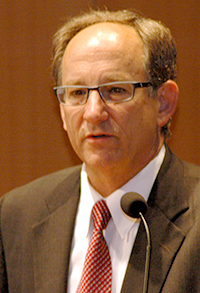Developing World Needs Farming Innovation to Ease Poverty, Says Gates’ Official Rob Horsch

Rob Horsch
Those who care about the poor must also care about agriculture and how to expand the use of innovative farming technology in the developing world, a top official of the Bill & Melinda Gates Foundation said recently at AAAS.
Rob Horsch, deputy director of research and development in the agricultural development program at the Foundation, said improved agriculture offers the biggest opportunity for the poor to lift themselves out of poverty.
Horsch delivered the 2012 AAAS Charles Valentine Riley Memorial Lecture at the AAAS Auditorium on 14 June. He said the Gates Foundation’s long-term goal is poverty reduction and agriculture holds the key. As Bill Gates wrote in his 2012 annual letter, “Farming is a great example of something critical to the poor that gets very little attention in rich countries.”
Three-quarters of the world’s poorest people live in rural areas and half of them are farmers, Horsch noted. A typical farmer is a woman living on less than a dollar a day and growing several crops on one-half to one whole hectare (1.2-2.4 acres) with no mechanization.
By using better land-management practices, he said, typical small farmers in a developing country could see their land’s output triple or more. Such dramatic improvements already have come for U.S. farmers, Horsch said, “because they’re already way high on the curve” of adopting new technology. But for farmers using low-productivity tools, such as poor quality seeds, and little or no attention to soil health, “it’s relatively simple to make a huge increase,” Horsch said. “That’s the good news.”
Over the last several decades, agricultural innovation led to decreased food prices and reduced poverty worldwide. However, Horsch said, in the last 30 years the rate at which agricultural innovation had been accelerating stalled, international agricultural assistance dropped, and consequently food prices began to increase about 10 years ago, reaching a crisis point in 2008.
“I’m not going to try and prove cause-and-effect here,” Horsch said, “but it’s a strong enough correlation and there’s an internal logic that suggests it’s probably all related—less investment, less progress, less productivity gains. Meanwhile, the world is growing, population’s increasing, incomes are increasing, and the demand on the food system [is] increasing... It’s supply and demand. Prices start to rise.”
Inaugurated in 2010, the Riley Lecture honors the legacy of Charles Valentine Riley, a former chief entomologist at the U.S. Department of Agriculture. The Charles Valentine Riley Memorial Foundation promotes the understanding and enhancement of agriculture through scientific knowledge. The lecture is sponsored in collaboration with the World Food Prize Foundation which recognizes individuals who improve the quantity, quality, or availability of food in the world.
Farmers who are poor also are consumers who are poor, Horsch said. While they want to benefit from selling food at higher prices, they also would like to buy food at lower prices. “There actually is a win-win approach, and it’s called productivity,” he said. During the Green Revolution in Asia, food prices tumbled as productivity increased. Economists estimated that 80% of the benefits of the Green Revolution went to impoverished consumers while 20% of the benefits went to low-income farmers. Productivity increased faster than prices decreased, allowing farmers to keep the difference.
“This is essentially the strategy that we’re trying to pursue,” Horsch said. “Driving productivity in a win-win situation where both farmers and consumers come off better at the end of the day.”
At the Gates Foundation, Horsch is focusing on three major outcomes of agricultural research and development: increasing productivity, decreasing risk to farmers, and fostering improved nutrition, specifically vitamin A, zinc, and iron enhancements in staple crops.
After his lecture, Horsch participated in a panel discussion with Bill Northey, Iowa secretary of agriculture, and Steven Pueppke, associate vice president for research and graduate studies at Michigan State University. The discussion was moderated by Catherine Woteki, undersecretary for the U.S. Department of Agriculture Office of Research, Education, and Economics and USDA chief scientist.
The U.S. has traditionally led the world when it comes to basic plant science, Horsch said, though decreased public investment in research is threatening that position. Northey advocated for increasing public investment in basic agricultural research. “When budgets are crazy-tight, everybody says, ‘If it can be done privately, it needs to be done privately,’” he said. “Yet there are some things that must be done publicly.”
The status of agricultural research needs to be improved so the field can attract the best students in the next generation of scientists, Pueppke said, explaining that he was shocked to learn recently that at his own university, some agricultural programs are not considered part of science, technology, engineering, and math (STEM). “I wish that agricultural research was more attractive to young people, the very best young people, because of the status and the importance of what we do.”
2 August 2012
Copyright © 2012. American Association for the
Advancement of Science.
All rights reserved. http://www.aaas.org